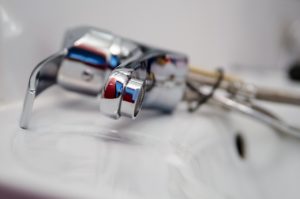 Dripping faucets aren’t just a nuisance – they also waste water. A faucet that drips 20 times per minute wastes nearly two gallons per day or 700 gallons per year. That’s a significant waste, not to mention money down the drain. Learn how to fix a dripping faucet, a simple DIY home plumbing repair that eliminates the annoying drip, drip, drip and puts money back in your pocket.
Dripping faucets aren’t just a nuisance – they also waste water. A faucet that drips 20 times per minute wastes nearly two gallons per day or 700 gallons per year. That’s a significant waste, not to mention money down the drain. Learn how to fix a dripping faucet, a simple DIY home plumbing repair that eliminates the annoying drip, drip, drip and puts money back in your pocket.
Getting Started
First, you must gather some basic supplies to fix a dripping faucet. Here’s what you need:
- Phillips-head screwdriver
- Flat-head screwdriver (a handy prying tool)
- Wrench
- Pliers
- Penetrating oil (WD-40 or CRC)
- Plumber’s grease
- Replacement O-rings and other parts for your specific faucet
Next, turn the water shut-off valve under the sink to stop the flow of water. After all, the last thing you need is for your dripping faucet to turn into Old Faithful! It’s also wise to plug the drain with the built-in stopper or a rag to prevent small parts from getting lost down the drain.
Determine What Type of Faucet You Have
Compression faucets have two handles, making them the easiest to spot by sight. The other types have a single handle that swivels from hot to cold as desired. You may need to disassemble the faucet before you know which one you have. Keep in mind that ball faucets contain a ball bearing, cartridge faucets typically have a decorative cap on the handle and feature a cartridge, and ceramic-disk faucets contain a ceramic cylinder.
Find Out Where the Water is Coming From
If the handles of your compression faucet are leaky, you can usually fix the problem with a simple O-ring replacement. To do this, pry the decorative cap off the handles, if necessary, and remove the stem to expose the O-ring. Replace this with a new O-ring and repeat on the other handle if needed.
A leak from the spout is a little more complicated to fix with techniques that differ depending on the type of faucet you have. Check out this World Water Day blog from Mr. Rooter Plumbing for more information about how to fix a dripping faucet.
Other Tips for Fixing a Dripping Faucet
When you use your screwdriver and wrench to remove parts, be careful to avoid scratching the finish. You may want to wrap the wrench with a cloth to protect your faucet.
If the handle stem of your compression faucet is difficult to pry out, apply penetrating oil, such as WD-40, to loosen it so you can remove it more easily.
Most kitchen and bathroom faucets feature several small components that may be unfamiliar to you. We recommend taking pictures as you go and laying out parts on a towel in the order you removed them to make reassembly easier once the task is complete.
In the case of older faucets, some parts beyond just the O-rings may need to be replaced. Soak any items coated with mineral deposits in a bowl of white vinegar for several hours. This will loosen the scaling and allow you to assess whether the parts are reusable. If not, you may need to replace the parts or buy a new faucet if parts aren’t available.

Recent Comments